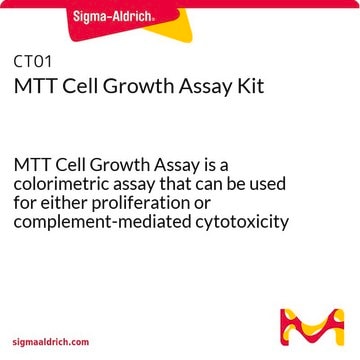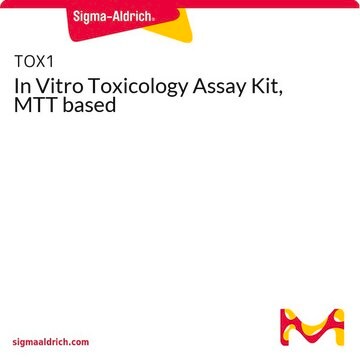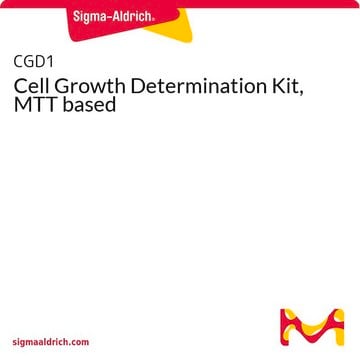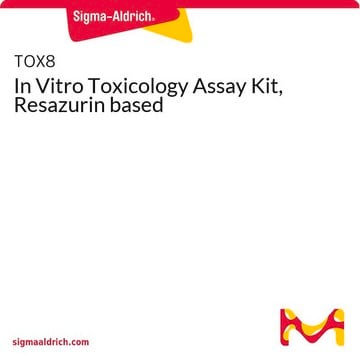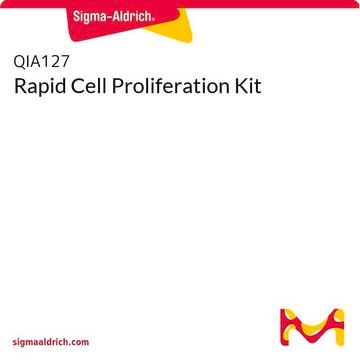CT02
MTT Cell Growth Assay Kit
MTT Cell Growth Assay is a colorimetric assay that can be used for either proliferation or complement-mediated cytotoxicity assays.
Synonym(s):
Formazan-based mitochondria cytotoxicity assay
Sign Into View Organizational & Contract Pricing
All Photos(1)
About This Item
UNSPSC Code:
12352207
eCl@ss:
32161000
NACRES:
NA.32
Recommended Products
Quality Level
manufacturer/tradename
Chemicon®
technique(s)
activity assay: suitable
cell based assay: suitable
shipped in
wet ice
Related Categories
General description
MTT is a pale yellow substrate that is cleaved by living cells to yield a dark blue formazan product. This process requires active mitochondria, and even freshly dead cells do not cleave significant amounts of MTT. The colorimetric assay described below can be used for either proliferation or complement-mediated cytotoxicity assays.
Application
Procedure:
1) Carry out a lymphokine, mitogen, or complement-mediated cytotoxicity assay using standard methods, in 96-well flat-bottomed tissue culture plates of good optical quality (e.g. Falcon). The final volume of tissue culture medium in each well should be 0.1 mL, and the medium (e.g. RPMI or DMEM) may contain up to 10% Fetal Bovine Serum.
2) At the end of the assay add 0.01 mL AB Solution (MTT) to each well. Mix by tapping gently on the side of the tray.
3) Incubate at 37° C for cleavage of MTT to occur. Optimal times may vary according to the assay, but four hours is suitable for most purposes. At the end of this time, the MTT formazan produced in wells containing live cells will appear as black, fuzzy crystals on the bottom of the well.
4) Add 0.1 mL isopropanol with 0.04 N HCl to each well. Mix thoroughly by repeated pipetting with a multichannel pipettor. The HCl converts the phenol red in tissue culture medium to a yellow color that does not interfere with MTT formazan measurement. The isopropanol dissolves the formazan to give a homogeneous blue solution suitable for absorbance measurement.
5) Within an hour, measure the absorbance on an ELISA plate reader with a test wavelength of 570 nm and a reference wavelength of 630 nm. After several hours at room temperature, serum proteins may begin to precipitate due to the acid/alcohol. Chilling the plates will hasten the precipitation. If the plates must be stored before measuring, keep at 4° C before adding the acid/alcohol, then warm to room temperature and add acid/alcohol just before reading.
Results:
The MTT assay will normally detect 200 to 50,000 cells of a typical cell line, although 1,000 to 50,000 is the useful range. This number may vary for other cell types. Cytotoxic assays should be set up so that the control, unlysed cells give a signal of 0.2 to 0.4, and proliferation assays should yield a similar value at plateau concentrations. This corresponds to about 20-50,000 cells per well with a typical cell line.
Absorbance is directly proportional to the number of cells; actual cells do not absorb significantly, even up to concentrations of 1 x 106 cells/mL.
1) Carry out a lymphokine, mitogen, or complement-mediated cytotoxicity assay using standard methods, in 96-well flat-bottomed tissue culture plates of good optical quality (e.g. Falcon). The final volume of tissue culture medium in each well should be 0.1 mL, and the medium (e.g. RPMI or DMEM) may contain up to 10% Fetal Bovine Serum.
2) At the end of the assay add 0.01 mL AB Solution (MTT) to each well. Mix by tapping gently on the side of the tray.
3) Incubate at 37° C for cleavage of MTT to occur. Optimal times may vary according to the assay, but four hours is suitable for most purposes. At the end of this time, the MTT formazan produced in wells containing live cells will appear as black, fuzzy crystals on the bottom of the well.
4) Add 0.1 mL isopropanol with 0.04 N HCl to each well. Mix thoroughly by repeated pipetting with a multichannel pipettor. The HCl converts the phenol red in tissue culture medium to a yellow color that does not interfere with MTT formazan measurement. The isopropanol dissolves the formazan to give a homogeneous blue solution suitable for absorbance measurement.
5) Within an hour, measure the absorbance on an ELISA plate reader with a test wavelength of 570 nm and a reference wavelength of 630 nm. After several hours at room temperature, serum proteins may begin to precipitate due to the acid/alcohol. Chilling the plates will hasten the precipitation. If the plates must be stored before measuring, keep at 4° C before adding the acid/alcohol, then warm to room temperature and add acid/alcohol just before reading.
Results:
The MTT assay will normally detect 200 to 50,000 cells of a typical cell line, although 1,000 to 50,000 is the useful range. This number may vary for other cell types. Cytotoxic assays should be set up so that the control, unlysed cells give a signal of 0.2 to 0.4, and proliferation assays should yield a similar value at plateau concentrations. This corresponds to about 20-50,000 cells per well with a typical cell line.
Absorbance is directly proportional to the number of cells; actual cells do not absorb significantly, even up to concentrations of 1 x 106 cells/mL.
Components
Reagent A: MTT, (3-(4,5-dimethylthiazol-2-yl)-2,5-diphenyl tetrazolium bromide), 50 mg/vial.
Solution B: PBS pH 7.4, 15 mL
Solution B: PBS pH 7.4, 15 mL
Storage and Stability
Maintain at 2-8°C for up to six months. The Reagent A / Solution B mixture is stable at 2-8°C for up to two weeks.
Reagent Preparation:
Add 10 mL Solution B to one vial of Reagent A. Mix well, sterile filter and keep in the dark at 4° C until used. Note: It may take overnight to dissolve. Do not heat solution. When absolutely required to dissolve crystals, adjust pH with 1-2 drops of HCl. The AB mixture is stable for several weeks under these conditions.
Reagent Preparation:
Add 10 mL Solution B to one vial of Reagent A. Mix well, sterile filter and keep in the dark at 4° C until used. Note: It may take overnight to dissolve. Do not heat solution. When absolutely required to dissolve crystals, adjust pH with 1-2 drops of HCl. The AB mixture is stable for several weeks under these conditions.
Legal Information
CHEMICON is a registered trademark of Merck KGaA, Darmstadt, Germany
Disclaimer
Unless otherwise stated in our catalog or other company documentation accompanying the product(s), our products are intended for research use only and are not to be used for any other purpose, which includes but is not limited to, unauthorized commercial uses, in vitro diagnostic uses, ex vivo or in vivo therapeutic uses or any type of consumption or application to humans or animals.
Signal Word
Warning
Hazard Statements
Precautionary Statements
Hazard Classifications
Eye Irrit. 2 - Muta. 2 - Skin Irrit. 2 - STOT SE 3
Target Organs
Respiratory system
Storage Class Code
10 - Combustible liquids
Certificates of Analysis (COA)
Search for Certificates of Analysis (COA) by entering the products Lot/Batch Number. Lot and Batch Numbers can be found on a product’s label following the words ‘Lot’ or ‘Batch’.
Already Own This Product?
Find documentation for the products that you have recently purchased in the Document Library.
Customers Also Viewed
The mammalian molecular clockwork controls rhythmic expression of its own input pathway components.
Martina Pfeffer,Christian M Muller,Jerome Mordel,Hilmar Meissl,Nariman Ansari et al.
The Journal of Neuroscience null
The effect of nicotine on the production of soluble fms-like tyrosine kinase-1 and soluble endoglin in human umbilical vein endothelial cells and trophoblasts.
Ja-Young Kwon,Sang-Wook Bai,Young-Guen Kwon,Se-Hoon Kim,Chul Hoon Kim,Moung Hwa Kang et al.
Acta Obstetricia et Gynecologica Scandinavica null
Genotypic variability and persistence of Legionella pneumophila PFGE patterns in 34 cooling towers from two different areas.
Inma Sanchez,Marian Garcia-Nu?ez,Sonia Ragull,Nieves Sopena,Maria Luisa Pedro-Botet et al.
Environmental Microbiology null
T Fujioka et al.
World journal of surgery, 24(10), 1205-1210 (2000-11-09)
We studied the serum levels of 1,25-dihydroxyvitamin D [1,25(OH)2D (Vit D)] in patients with renal cell carcinoma (RCC) and the influence of 1,25(OH)2D3 (Vit D3) on gap junctional intercellular communication (GJIC) during carcinogenesis. The serum Vit D levels were measured
Praveen Bhoopathi et al.
Cancer research, 76(12), 3572-3582 (2016-05-20)
Advanced stages of neuroblastoma, the most common extracranial malignant solid tumor of the central nervous system in infants and children, are refractive to therapy. Ectopic expression of melanoma differentiation-associated gene-7/interleukin-24 (mda-7/IL-24) promotes broad-spectrum antitumor activity in vitro, in vivo in
Our team of scientists has experience in all areas of research including Life Science, Material Science, Chemical Synthesis, Chromatography, Analytical and many others.
Contact Technical Service
